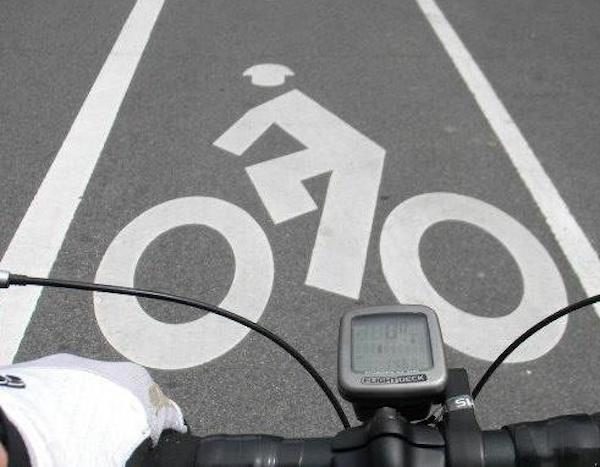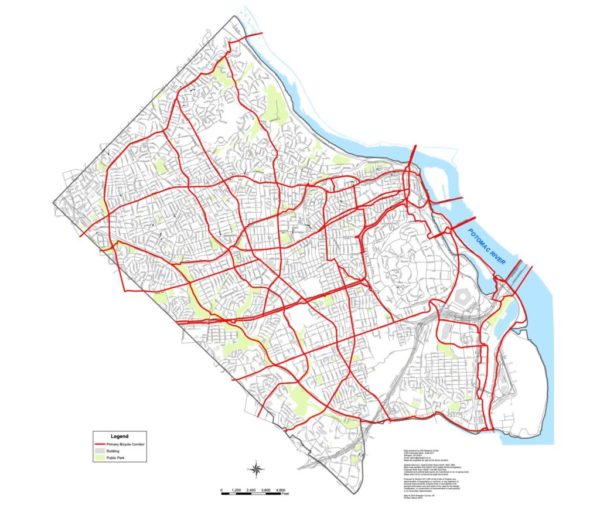(Updated at 11:30 a.m.) The Arlington County Board unanimously passed a new master bike plan Wednesday night.
The Board approved the guiding infrastructure “wish list” for the county after four hours of deliberations and four amendments, and two years of community engagement. Dozens of residents testified, with about half of them opposing a proposed trail in Alcova Heights, and the other half asking for more safe bike routes.
Ultimately, the Board unanimously agreed to strike a potential plan seeking access to private property in Alcova Heights for a trail, as well as add references to new national highway standards that recommend protected bike plans.
And with that, @ArlingtonVA becomes (likely) the first jurisdiction to reference the new @USDOTFHWA bike guidance.
Nicely done adopting a strong plan for our future https://t.co/AJddEMkxkP
— Gillian Burgess (@BikeGillian) April 24, 2019
Though some activists criticized the plan for being too vague, it broadly calls for around 100 projects “currently envisioned to occur by the year 2040” to improve cycling and pedestrian infrastructure. All told, the projects aim to renovate 18 miles of trail and add up to 9 miles of new trails. They would also add up to 75 miles of on-street bikeways to the county, but only 2.5 miles of protected bicycle lanes.
Examples from Appendix D of the plan include:
- Four Mile Run & W&OD Trail Improvements in Benjamin Banneker Park — “Renovate trails within the park and widen the primary sections of the Four Mile Run & W&OD Trails pavements to 12 feet. Widen the W&OD Trail to 10 feet wide north of Four Mile Run towards N. Tuckahoe Street, and incorporate modified signs, new markings to enhance safety and reduce conflicts between users.”
- Route 110 Trail Upgrades — “Upgrade the entire Route 110 Trail for improved user safety and comfort. Improvements should include trail widening to a minimum 10 feet of paved width, new pavement markings, wayfinding signage and consideration of the addition of trail lighting.”
- Army Navy Drive Protected Bicycle Lanes — “Reconstruct Army Navy Drive between 12th Street South and S. Joyce Street to include a bi-direction protected bicycle lane.”
- N. Glebe Road Bicycle Facility — “Implement an enhanced bicycle facility on N. Glebe Road between Old Glebe Road and Arlington Boulevard to provide better north-south bicycle connectivity within Arlington.”
- Fort Myer Drive Protected Bike Lanes — “Install a protected bicycle lane(s) on Fort Myer Drive from Lee Hwy near the Custis Trail to the North Meade Street Bridge.”
- Roosevelt Bridge to Mt. Vernon Trail — “Include a connection from the Theodore Roosevelt Bridge to the Iwo Jima Memorial roadway in a reconstruction of the bridge. This connection would improve access to Rosslyn and the Fort Myer Heights neighborhood.”
The plan — formally titled the Master Transportation Plan Bicycle Element — calls for repaving and renovating parts of the trails that act as “primary” routes for many cyclists, namely the Custis, Four Mile Run, W&OD and Bluemont Junction trails and trails that run along Arlington Blvd.
Other improvements recommended for these trails include installing lighting, improving crossings and signage, and potentially widening the trails to “address user conflicts” according to a Tuesday staff presentation.
More nebulously, the Bicycle Element plan recommends Arlington create enhanced bicycle facilities which means staff should study what kind of bike lanes or other infrastructure is best suited to fit a proposed project site — such as the the two miles of Wilson Boulevard between the county line and N. Glebe Road.
“The death of Mr. Salovesh makes all this particularly poignant,” Board Chair Christian Dorsey said, referring to outspoken cycling advocate Dave Salovesh who was hit and killed last Friday in a shared car-and-bike lane in Northeast D.C.
Many bike advocates that showed up last night knew Salovesh personally, and spoke through tears as they urged Board members to include more protected bike lanes in the county’s future plans, and be specific about what exactly they wanted to accomplish.
“It was a freak sort of thing that we would like to think wouldn’t happen here in Arlington,” said Arlington County’s Bicycle Advisory Committee Chair Gillian Burgess, of the crash that killed Salovesh. “But it could on Lee Highway, it could on Washington Blvd, on George Mason. We need to make sure we’re making protected safe places for people to ride their bikes.”
Moving testimony tonight by @bikepedantic at the @ArlingtonVA Master Transportation Plan draft bike element hearing, in memory of @darsal. I'm not crying, you're crying. #bikeDC #bikeVA cc: @BikeGillian @randomduck @srepetsk https://t.co/eZBQrISq7M
— Aimee Custis (@AimeeCustis) April 24, 2019
“I’m asking you to care,” Mark Blacknell, former president of the the Washington Area Bicyclist Association said, adding, “We need to choose life on our streets.”
“Your pain came through and we grieve for you,” Dorsey said to the meeting attendees at the end of the night. “We certainly don’t want that to be our experience in Arlington.”
Pedestrian Advisory Committee member Pamela Van Hine testified that protected bike lanes also help other groups.
“Many cyclists and scooters are not comfortable riding on our streets,” she said. “And that’s bad for those of us on sidewalks.”
A dozen residents of Alcova Heights testified that ongoing conversations about the county potentially seeking an easement on private property for a half-mile trail connecting 6th Street S. to S. Quincy Street felt “disingenuous.”
20th speaker also owns private land that would have been needed for NFATC trail connection if connecting to 6th instead of Quincy. Says trail on GSA land too expensive, concerned when that becomes clear would.come back and want her private land again.
— Sustainable Mobility for Arlington County (@susmoarlington) April 23, 2019
The Board struck private property easements from the Alcova plan in their final vote after officials promised future bike plans would not take any private property — a guarantee which bike advocates said was impossible due to the county’s limited space.
The Audubon Society also testified about concerns that “trail widening and lighting plans” may not follow the county’s natural resource plan. The Board also amended the Bicycle Element to note it should take the resource plan into account.
The 50-page bike plan is a kind of guiding “wish list” for the county, planner Richard Viola has said, and it’s part of the county’s 2008 Master Transportation Plan.
Viola and his team at the Department of Environmental Services, which has worked on updating the plan, doesn’t expect another update for another decade. Their first draft of the new plan laid out 26 new projects, which included new trails, on-street lanes, and path renovations.
The document shows about 29 miles of bike lanes, but only about 10 percent are protected, attorney and bike advocate Bruce Deming told ARLnow last month.
Viola previously told ARLnow that his team shelved a few other plans before the final version of the document went to the Board. One was the original idea behind his team’s plan to widen the sidewalk on eastbound Carlin Springs Road enough for bikes and pedestrians.
Originally Viola’s team wanted to construct a half-mile “low-stress” trail connecting Glencarlyn and Forest Hills neighborhoods through the old site of the Northern Virginia Community Hospital instead. Planners dropped the idea after complaints from the Audubon Society that the trail would “destroy valuable natural resources” in the Long Branch Creek conservation area.
Viola’s team also nixed a plan to extend the Four Mile Run Trail half a mile to connect with Claremont Elementary and Wakefield High after the Audubon Society said it could “potential harm” the area’s magnolias. A steep, unpaved trail already connects the schools’ neighborhood with the Four Mile Run Trail.
Last night, Board member Libby Garvey said her husband Kennan, who passed away in 2008 and was an avid cyclist before most of the county’s bike safety infrastructure was available, and “would be thrilled to see what’s going on now.”
Photo courtesy of Sal Ferro. Screenshot via Arlington County.



